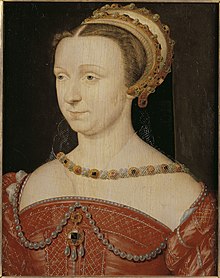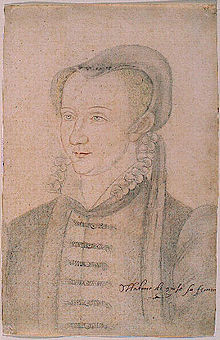Anna d'Este
This article includes a list of generalreferences,butit lacks sufficient correspondinginline citations.(April 2014) |
| Anna d'Este | |
|---|---|
| Duchess consort of Nemours prevDuchess consort of Guise | |
 Portrait by an unknown artist, 2nd half of the 16th century, oil on wood. Versailles, Musée du Château | |
| Born | 16 November 1531 Ferrara,Italy |
| Died | 17 May 1607(aged 75) Paris,France |
| Spouse | |
| Issue | Henry I, Duke of Guise Catherine, Duchess of Montpensier Charles, Duke of Mayenne Louis II, Cardinal of Guise Charles Emmanuel, Duke of Nemours Henri I, Duke of Nemours |
| House | Este |
| Father | Ercole II d'Este |
| Mother | Renée of France |
Anna d'Este(16 November 1531 – 17 May 1607) was an important princess with considerable influence at the court of France and a central figure in theFrench Wars of Religion.In her first marriage she was Duchess ofAumale,then ofGuise,in her second marriage Duchess ofNemoursandGenevois.
Life
[edit]
Anna d'Este was born on 16 November 1531, the eldest daughter of the Duke of FerraraErcole II(son ofLucrezia Borgiaand grandson ofPope Alexander VI) and his wife,Renée of France(daughter of KingLouis XII of France).[1]She grew up in Ferrara, where she received an excellent education. The future writer and scholarOlympia Fulvia Moratawas chosen as one of her companions at court.[2]
In 1548, after long and difficult negotiations, her marriage was arranged with the French princeFrancis,Duke of Aumale, son of theDuke of Guise.The contract was signed inFerraraon 28 September and the marriage was held inSaint-Germain-en-Layenear Paris on 16 December. The princess was never to return to Italy. Anna was the granddaughter of the French kingLouis XIIand therefore related toHenry IIand his sons.[citation needed]
By her marriage she had become a member of the powerfulGuise family,and because of her Italian roots she had especially close ties to the queen and later queen-mother,Catherine de' Medici.For these reasons, her position at court was outstanding. Duchess of Guise after the death of her father-in-law in 1550, she governed the family estates and the enormous fortunes of the Guise with the help of her mother-in-law,Antoinette de Bourbon.She was active on behalf of her father and acted as mediator between the courts of France and of Ferrara. She gave birth to seven children, four of whom reached adulthood.[citation needed]

In February 1563Francis, Duke of Guise,was assassinated. While the murderer was seized and immediately put to death, Anna took all possible steps to sue the leader of the French Huguenots,Gaspard de Coligny,whom she held responsible.[clarification needed]During the next three years, the widow put pressure on the king and his courts of justice with her petitions, but in January 1566 the king's council declared the admiral of Coligny innocent and imposed eternal silence in the matter. Consequently, most of her contemporaries held the widow of the Duke of Guise responsible for the shot which was fired on Coligny on 22 August 1572 and which became the starting signal for theSt. Bartholomew's Day massacre.[citation needed]

On 29 April 1566, Anna marriedJacques of Savoy,Duke of Nemours and Genevois. Henceforth, the princess spent most of her time inAnnecyor on the road between her duchy ofGenevoisand the court of France. In politically difficult situations she acted as mediator between her husband and the Duke ofSavoy,and in the meantime she held her position at the court of France. Anna promoted her sons' careers, she helped her clients to make their living, and she claimed a prominent place in official ceremonies at court. After the death of her second husband in 1585, Anna lived in Paris, in herHôtel de Nemours,on the left bank of the Seine, in what is today Rue Séguier. With the formation of theCatholic League,in which her sons played a prominent part, her importance increased considerably.[citation needed]
In December 1588Henry IIIordered the murder of her two oldest sons and the imprisonment of Anna d'Este. Although the sources tell us nothing about the deeds of the Duchess after her liberation, some contemporaries held her responsible for the assassination of the king. During the siege of Paris byHenry IV,Anna was declared "queen-mother" by the League, but after the Bourbon's conversion back to Catholicism she recognized him as king and tried to convince her rebellious sons to take the same step. In 1594 Anna traveled to Paris to pay homage to Henry IV. Anna spent her last years in the highly respectable position of "superintendante de la maison" of the queen,Marie de' Medici,but also in growing indebtedness and in constant worry about the financial situation of her children and grandchildren.[citation needed]
Death
[edit]When she died on 17 May 1607, the value of her movable goods came to little more than 4000livres.The entrails and the heart of the Duchess were interred in Paris and in Joinville while her body was brought to Annecy, where it was buried next to her second husband. None of the tombs remain.[citation needed]
Significance
[edit]
With regard to the confessional disputes, Anna's life does not differ much from those of other princesses of her time. Her mother was aCalvinist,her father, husbands, and sons were more or less radicalCatholics.She helped to increase the acceptance of Henry IV following his conversion to Catholicism.[3]In other regards, she held a special position at the court of France, which can be seen from the numerous lawsuits she was involved in. Although the entanglement in legal proceedings even for minor causes was quite common for the French aristocracy of the early modern period, it was Anna and her mother who contested the king's right toBrittany,and in doing so they referred to their positions as daughter and granddaughter of a French king.[citation needed]
Family
[edit]
Children from the marriage withFrancis, Duke of Guise(1519–1563):
- Henry,prince of Joinville, then Duke of Guise (1550–1588)
- Catherine, Duchess of Montpensier(1551–1596), marriedLouis, Duke of Montpensier
- Charles,Marquis, then Duke of Mayenne (1554–1611)
- Louis,archbishop of Reims, then Cardinal of Guise (1555–1588)
- Antoine (1557–1560)
- François (1559–1573)
- Maximilien (1562–1567/68)
Children of the marriage withJacques de Savoie(1531–1585):
- Charles Emmanuel,prince of Genevois, then Duke of Nemours (1567–1595)
- Marguerite (1569–1572)
- Henry I,Marquis of Saint-Sorlin, then Duke of Nemours (1572–1632)
- Emmanuel Philibert (died young)
Ancestry
[edit]| Ancestors of Anna d'Este |
|---|
Notes
[edit]- ^Peebles & Scarlatta 2021,p. 6.
- ^Parker 2007,p. 269.
- ^"Anne d'Este".The British Museum.Retrieved2022-06-16.
- ^abAnselm 1726,pp. 126–128.
- ^abAnselm 1726,pp. 207–208.
- ^Anselm 1726,pp. 463–465.
- ^abcAnselm 1726,p. 465.
- ^Anselm 1726,pp. 205–206.
- ^Anselm 1726,p. 206.
- ^abAnselm 1726,p. 208.
- ^abAnselm 1726,pp. 462–463.
Sources
[edit]- Anselm de Gibours(1726).Histoire généalogique et chronologique de la maison royale de France[Genealogical and chronological history of the royal house of France] (in French). Vol. 1 (3rd ed.). Paris: La compagnie des libraires.
- Peebles, Kelly Digby; Scarlatta, Gabriella, eds. (2021).Representing the Life and Legacy of Renée de France: From Fille de France to Dowager Duchess.Palgrave Macmillan.
- Parker, Holt (2007). "Morata, Fulvia Olympia, (1526/1527–1555)". In Robin, Diana Maury; Larsen, Anne R.; Levin, Carole (eds.).Encyclopedia of women in the Renaissance: Italy, France, and England.ABC-CLIO, Inc.
Further reading
[edit]This sectionlacksISBNsfor the books listed.(April 2014) |
- Henry Gardiner Adams, ed. (1857). "Anne of Ferrara".A Cyclopaedia of Female Biography:53.WikidataQ115750637.
- Christiane Coester:Schön wie Venus, mutig wie Mars. Anna d'Este, Herzogin von Guise und von Nemours (1531–1607).Oldenbourg, Munich (2007);ISBN978-3-486-58028-0.
- Huguette Leloup:Anne d'Este (1531–1607). Fille aînée de Renée de France, Duchesse de Guise puis duchesse de Nemours, Dame de Montargis.Special issue of the Bulletin de laSociété d'Émulation de l'Arrondissement de Montargis.3rd ser., pp. 119, 2002.
- Jessica Munns, Penny Richards:Exploiting and destabilizing Gender Roles: Anne d'Este.In:French History.Vol. 6 (1992), pp. 206–215.
- Matteo Sanfilippo:article: Este, Anna d'.In:Dizionario biografico degli Italiani.Vol. 43, Istituto della Enciclopedia Italiana, Rome (1993), pp. 315–320.
External links
[edit] Media related toAnna d'Esteat Wikimedia Commons
Media related toAnna d'Esteat Wikimedia Commons- Coester, Christiane (2 November 2008)."Extrait de l'inventaire après décès d'Anne d'Este (1531–1607), dressé à l'hôtel de Nemours du 22 mai au 3 juillet 1607"(in French).
- Coester, Christiane (3 May 2009)."Livre de comptes d'Anne d'Este de l'année 1593"(in French).
- House of Guise
- 1531 births
- 1607 deaths
- Princesses of Joinville
- Duchesses of Guise
- House of Este
- 16th-century French women
- 17th-century Italian women
- Duchesses of Aumale
- Duchesses of Nemours
- Princesses of Savoy
- Modenese princesses
- Princesses of Lorraine
- People of the French Wars of Religion
- Italian ladies-in-waiting
- French ladies-in-waiting
- Household of Catherine de' Medici
- Daughters of dukes
